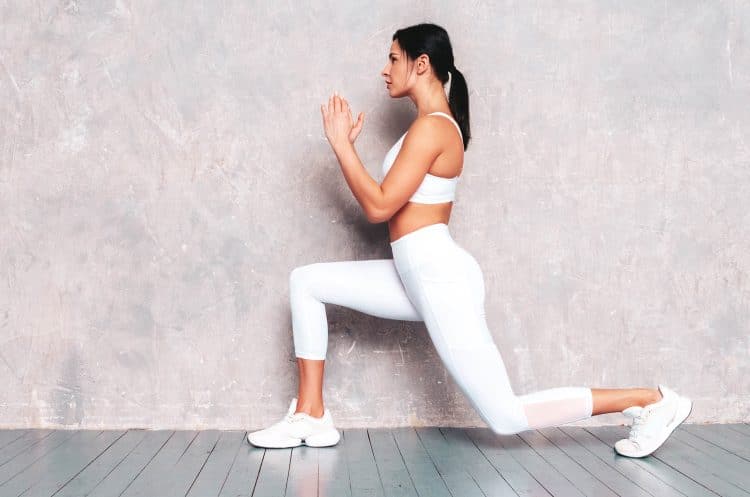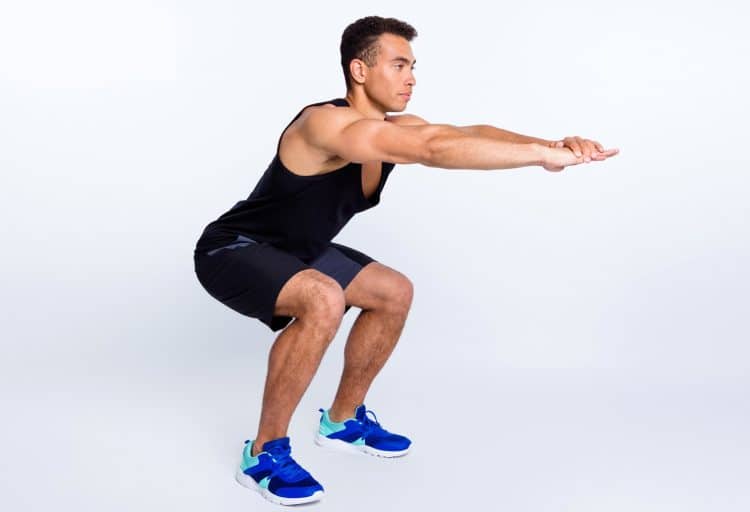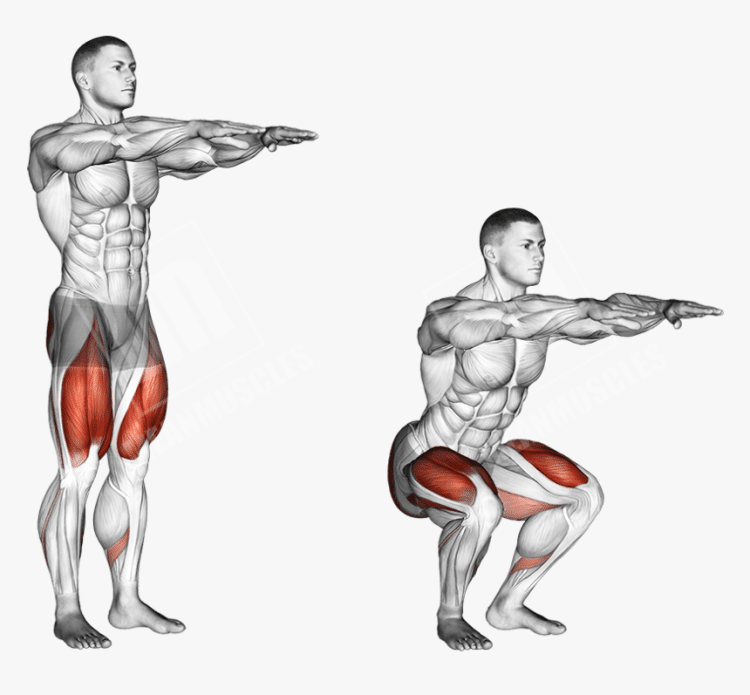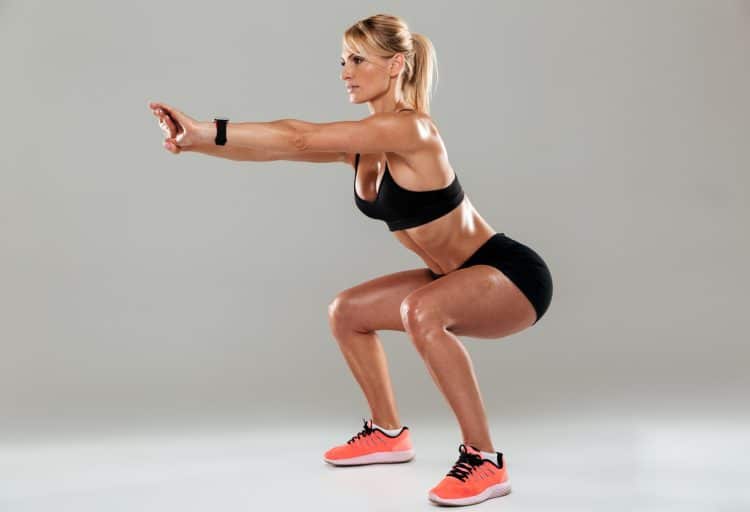Squats are the crowned king of lower body exercises. Very few movements are as effective or efficient as squats, and they deserve a place in almost every type of workout.
Not only are squats a great exercise, but they’re also a movement pattern that most people do many times each day. It’s actually pretty hard to avoid doing squats. Sitting down in a chair? A squat! Getting out of a chair? A squat! Climbing in and out of your car? More squats? Walking upstairs? A whole bunch of single-leg squats!
You get it – squats really are everywhere.
But what happens when you prioritize squats and do them every day for a month? Not just a few reps, but 100.
That’s what the 30-day 100-rep squat challenge is all about!
In this article, we reveal the benefits and drawbacks of this popular fitness challenge and how to get the best results.
Level Up Your Fitness: Join our 💪 strong community in Fitness Volt Newsletter. Get daily inspiration, expert-backed workouts, nutrition tips, the latest in strength sports, and the support you need to reach your goals. Subscribe for free!
What is The 100 Squats A Day Challenge?
The 100 squats-a-day challenge is as straightforward as it sounds – do 100 air squats every day for a month.
How you do those squats is up to you, but options include the following:
- 10 sets of 10
- 5 sets of 20
- 4 sets of 25
- 2 sets of 33 and 1 set of 34
- 2 sets of 50
- 1 set of 100
You can do your reps in the usual fashion, resting for 1-2 minutes between each set, or, if you prefer, you can spread your squats throughout the day, doing a few reps every hour or so.
This second approach is called Greasing the Groove, or GTG for short, and is a great way to accumulate a lot of reps without getting too tired.
You don’t even have to use the same method every day. For example, you could do each one for five days, ending the 30 days with sets of 100 non-stop reps. This would be an excellent way to make the challenge more manageable and progressive.
Alternatively, you could mix things up from one day to the next, e.g., 10 sets of 10 one day and four sets of 25 the next. Your options are almost endless.
Ultimately, it’s up to you how you do the 100 squats-a-day challenge. So long as you do 100 reps per day for 30 days, you will have successfully completed the challenge.
Air Squat Anatomy 101
Most people know that squats are an effective leg exercise, but what muscles are you actually working when you do them?
Keep reading to find out!
Squats are a compound bodyweight exercise. That means they involve two or more joints and multiple muscles working together. In simple terms, squats work all the muscles from your feet to your hips.
That said, the main muscles trained during squats are:
Quadriceps
Located on the front of your thighs, the quadriceps, or quads for short, is a group of four muscles – the rectus femoris, vastus lateralis, vastus medialis, and vastus intermedius. These muscles work together to extend your knees, and the rectus femoris is also a powerful hip flexor. The quads are the muscles that most people feel working during squats.
Gluteus maximus
The glutes are the largest muscle in the human body. Located on the back of your hip, they’re basically your butt. The glutes are your main hip extender and are very active during squats. The deeper you go, the more work the glutes have to do.
Hamstrings
Located on the back of your thighs, the hamstrings are a group of three muscles – the biceps femoris, semimembranosus, and semitendinosus. The hamstrings are responsible for flexing your knees and extending your hips. However, while they are involved in squats, they are not as active as the quads and glutes.
Abductors
The abductors are responsible for lifting your legs out and away from the midline of your body. Located on the outside of your hips and thighs, the abductors include the gluteus minimus and medius and tensor fascia latae. During squats, the abductors mainly act as stabilizers, preventing your knees from collapsing inward.
Adductors
Located on the inside of your thighs, the adductors are responsible for drawing your legs in toward the midline of your body. During squats, they help prevent your knees from caving inward. The adductor muscles include the longus, brevis, and magnus. A wide stance tends to increase adductor activation, and they’re more active if you squat lower than parallel.
Triceps surae
More commonly known as your calves, the triceps surae is a group of two muscles – the gastrocnemius and soleus. Together, these muscles extend your ankle, which is a movement called plantar flexion. Gastrocnemius also works with your hamstrings to flex your knee.
Your calves don’t have a lot of work to do during squats, but they are working to stabilize and control your ankles.
Core
The core is the collective term used for the muscles of your midsection, including the rectus abdominis, obliques, transverse abdominis, and erector spinae. Your core muscles don’t have a lot of work to do during bodyweight squats, but they’re still working to stabilize your lumber spine.
You can make bodyweight squats a little more core-centric by actively bracing your abs throughout your sets.
How to Do the Perfect Bodyweight Squat
There are two ways to do any exercise – the right way and the wrong way. The right way is safe and effective, while the wrong way is usually less effective and could lead to injury. Needless to say, the right way is the best way!
So, get the most from your 100 squats-a-day challenge by doing your reps correctly.
- Stand with your feet roughly shoulder-width apart, toes turned slightly outward.
- Hold your arms down by your sides.
- Look straight ahead, pull your shoulders down and back, and brace your core.
- Bend your knees, push your hips back, and squat down until your thighs are roughly parallel to the floor. Descend further if your mobility and knee health allow. Raise your arms forward to shoulder height for balance if required.
- Do not round your lower back. Make sure your heels stay firmly planted on the floor.
- Stand back up, extending your knees and hips at the top of each rep. Lower your arms as you come up.
- That’s one rep – only 99 left to do!
Why does form matter so much during the 100 squats-a-day challenge? Good question!
Minor technical errors, such as rounding your lower back, take stress off the target muscles and shift it onto ligaments, tendons, and other structures. While this stress shift is small, when you’re doing 100 reps, it soon starts to add up.
Doing your reps with perfect form will reduce your injury risk, make your workout more comfortable, and increase your chance of completing the challenge.
100 Squats-a-Day Challenge – Benefits
So, why should you even think about doing 100 squats a day? There are actually several good reasons that this challenge is worth your time and energy. The benefits of the 100 squats-a-day challenge include:
Improved muscular endurance
Muscular endurance is your ability to generate low amounts of force for extended periods. In simple terms, it’s your ability to resist fatigue and keep on going. More endurance means that everyday activities like walking or climbing stairs are less tiring, so you’ll have more energy. Endurance is also essential in most sports.
Increased muscle size
While doing 100 squats a day won’t give you bodybuilder-sized thighs, it could increase muscle size slightly. That’s especially true if you don’t usually do a lot of squats, are a beginner, or are currently deconditioned.
More muscle strength
High-rep bodyweight squats can make you stronger. However, those strength increases will be pretty small. In general, building strength is best done by lifting heavy weights for low reps. However, and especially if you are new to bodyweight squats, you should still get a little stronger over the course of the 30-day 100 squats challenge.
Firmer, more toned legs
Doing squats every day will give you firmer, more toned legs. Muscle tone means different things to different people. From a physiological perspective, tone refers to the readiness of a muscle to contract. A toned muscle is firm to the touch, even at rest.
In gym-speak, being toned means being able to see the shape of your muscle. This is the result of low levels of body fat. This type of muscle tone has more to do with diet than exercise, but doing 100 daily squats could help you lose fat, so you may achieve this effect too.
Improved mobility
Squats involve a large range of motion at your hips and knees. Initially, you may find that you cannot squat very deeply. But, as you accumulate more reps and workouts, you should notice that your movements become larger and smoother. Tight muscles will be much less so, and you’ll be able to squat deeper with less effort.
This improved mobility could result in fewer aches and pains and may even improve your athleticism.
Better squat technique
The best way to get good at something is to do it often. That’s true for almost anything, from learning to play the guitar, mastering a new language, or getting better at an exercise. Doing squats every day for 30 days will give you all the time you need to practice and perfect your technique. In one month, and after 3,000 reps, you’ll be a certified squat master!
However, you MUST do your squats properly. Poor form will get worse the more reps you do.
Improved cardiovascular fitness
High-rep squats will leave you feeling out of breath and with your heart beating faster than usual. That’s because the muscles you use during squats are large and demand a lot of oxygen to function correctly.
Doing a lot of squats will tax your heart and lungs, and they’ll respond by getting more efficient. As your fitness improves, squats will feel easier, and your heart and breathing rates won’t increase as much.
This shows that your workouts are having a positive impact on your cardiovascular fitness.
Level Up Your Fitness: Join our 💪 strong community in Fitness Volt Newsletter. Get daily inspiration, expert-backed workouts, nutrition tips, the latest in strength sports, and the support you need to reach your goals. Subscribe for free!
Develop the training habit
Exercise works best when you do it consistently. A lot of people only train sporadically, missing more days than they work out. This is why they find it so hard to get fit and lose weight.
The 30-day squat challenge teaches you how to exercise every day. After a month of doing 100 squats, working out will be more habitual.
Once established, habits are hard to break. While that’s bad news if you’re trying to give up smoking or quit eating sugar, it is actually excellent news if you want to make exercise part of your daily routine.
Satisfaction and pride
The 100 squat-a-day challenge is called a challenge for a reason – it’s not easy. Doing 100 squats every day requires determination, willpower, and motivation.
There will be days when you don’t feel like doing any squats, or you might not have time to do your workout. However, if you want to complete the challenge, you’ll have to push these barriers to the side and power on through.
Completing this or any similar workout challenge should be a source of satisfaction and pride. Feel free to boast about your achievement to your friends!
100 Squats-a-Day Challenge – Drawbacks
Doing 100 squats for 30 days should be a positive and rewarding experience. However, there are a couple of drawbacks you need to consider before you start this challenge. These include:
Overuse injuries
Doing 100 squats a day could leave you with sore hips and knees. That’s especially true if you are not used to working out regularly. You can reduce your risk of overuse injuries by warming up before each workout and performing your reps with perfect form.
If you are new to bodyweight squats, spending a few weeks perfecting your technique and gradually increasing training volume may also be beneficial.
For example:
- 1st week: 20 squats per day
- 2nd week 2: 30 squats per day
- 3rd week: 50 squats a day
- 4th week: 70 squats a day
- 5th week: Start the 100 squats-a-day challenge
Muscle imbalances
While squats work all your major lower body muscles, some are working harder than others. Squats are predominately a quadriceps-dominant exercise, and only doing squats for your legs could mean that your hamstrings, abductors, and adductors don’t get trained as hard.
Muscle imbalances can result in aches, pains, and joint dysfunctions, so you should supplement your daily squat workouts with a few additional exercises to ensure all muscles are developed equally.
Good exercises that will complement your squat workouts include:
- Hip thrusts
- Nordic curls
- Leg curls
- Single-leg Romanian deadlifts
- Kettlebell swings
You don’t need to do all these exercises or do them every day. Instead, a couple of sets of 1-2 exercises a couple of times a week will suffice.
Related: How to Correct Muscle Imbalances – The Ultimate Guide
Boredom
While squats are awesome, doing them daily could soon become a chore. If you start to get bored of the 100 squats-a-day challenge, you are less likely to complete it. Unfortunately, this is part and parcel for this kind of single-exercise challenge.
Ways to overcome boredom include:
- Do your squats to music
- Vary your sets and reps from workout to workout
- Do your squats with a friend
- Video your squat workouts and post them on social media
- Try doing some different squat variations…
Variations for the 100 Squats-a-Day Challenge

While the air squat is the exercise of choice for this challenge, that doesn’t mean you can’t use an alternative movement.
For example, you could do different squat variations from time to time to prevent boredom or do an entirely different type of squat for the duration of the 30-day challenge.
So long as you hit that magical 100 reps, then it’s all good!
Squat variations that will work well include:
100 Squats-a-Day FAQs
Got a question about the 100 squats-a-day challenge? No worries because we’ve got the answers!
1. How many calories will I burn doing 100 squats?
While squats are a very energetic exercise, you probably won’t burn a whole lot of calories doing them. Simply put, even 100 squats are not really much physical activity, and won’t contribute a lot to your total daily calorie expenditure. At best, you can expect to burn 30-40 calories per 100 squats.
Read more about squats and calorie burning here.
2. What is the best time to do my 100 squats?
The best time to do your squats depends on your preferences and schedule. For example, some people prefer to exercise soon after getting up. In contrast, others do better when they work out at lunchtime or in the evening.
Choose the time that works best for you and that you can do consistently. Remember, this is a 30-day challenge, so you need to do all 30 squat workouts in a row.
If that sounds a little daunting, remember you can always use the GTG method and spread your reps throughout the day. This may be more manageable and convenient for some people. However, this flexible structure also means it’s easy to put your squats off until later, and not do them at all.
3. How do I avoid skipping workouts?
One of the objectives of the 30-day squat challenge is to test and develop your willpower. Needless to say, missing a workout means you’ve failed the challenge. Ultimately, it’s up to you whether you complete the challenge or not.
That said, strategies that may make it easier to avoid missing workouts include:
- Schedule your workouts, so you do them at the same time every day. For example, it’s 8am, so it’s squat time!
- Give $300 (30 x $10) to a friend or partner and tell them they can keep $10 for each of the 30 workouts you skip. The fear of losing money is a great motivator!
- Get a calendar and put it somewhere prominent. Cross off each day you do your 100 squats. Try to maintain your unbroken streak, and don’t miss any days.
- Tell your friends or social media followers you are doing this challenge. Post videos of your workouts. They’re sure to call you out if you quit before the end.
Finally, remember that 100 squats are probably less than ten minutes of exercise per day. There aren’t many acceptable excuses for not doing them. The only legitimate reason for not completing the 30-day challenge is illness or injury. Laziness is NOT acceptable!
4. Are 100 squats all I need to do?
Doing 100 squats a day is a good start, but it’s not really much of a workout. After all, it’ll be all over in 10-20 minutes, and squats only work your lower body.
Ideally, you should run this challenge alongside a balanced workout program that trains the rest of your body and involves some cardio.
For example:
| Monday | 100 squats | Upper body |
| Tuesday | 100 squats | Cardio and core |
| Wednesday | 100 squats | Lower body |
| Thursday | 100 squats | Upper body |
| Friday | 100 squats | Cardio and core |
| Saturday | 100 squats | Lower body |
| Sunday | 100 squats | Rest |
5. Are there any other similar challenges I can try?
So, you like 30-day challenges, do you? Here are a few more to try!
- 100 push-ups a day
- 50 pull-ups a day
- 90-second plank every day
- Walk three miles every day
- Run a mile every day
- 100 burpees every day
- 1000 jump rope turns every day
- CrossFit Murph workout every day
- CrossFit Cindy workout every day
You could even combine challenges to create a balanced workout. For example:
- 50 pull-up challenge
- 100 push-ups challenge
- 100 squats challenge
- 90-second plank challenge
- Run one-mile challenge
6. What should I do after I finish the 100 squats a day challenge?
The most important thing to do is DO NOT STOP WORKING OUT! 30 days of squats will have had a significant impact on your fitness, and taking a long break will undo many of those hard-won benefits.
So, after congratulating yourself for a job well done, make sure you get back to training ASAP to maintain your gains. For example, you could pick another challenge, increase the duration of your squat challenge to 45 or 60 days, or just adopt a more conventional program for the next few weeks.
Use your newly developed discipline and willpower to push your fitness to new, higher levels. Think of this challenge as a springboard onto bigger and better things!
100 Squats-a-Day – Closing Thoughts
A lot of so-called fitness challenges are nothing but click-bait BS. They are of no benefit and will have no lasting effect on your fitness or health. The 100 squats-a-day 30-day challenge is different.
Firstly, squats are one of the best exercises you can do. Whatever you are training for, squats will get you there sooner.
100 is a good number of reps to shoot for, and experienced exercisers will have to work hard to do 100 perfect air squats.
30 days is also a decent timeframe. It’s long enough to require a good level of commitment and should produce noticeable results, but it is also realistic and manageable.
Will doing 100 squats a day transform your body? Probably not. However, it’s a good start and should provide you with the motivation and willpower you need to continue working on your fitness and conditioning.
Not a fan of squats? Why not create your own 30-day challenge?
It doesn’t even have to be exercise related. For example, how about eating vegetables every day for 30 days, or drinking 64 fluid ounces of water, getting eight hours of sleep, or a social media fast?
Any and all of these things will do you good!












